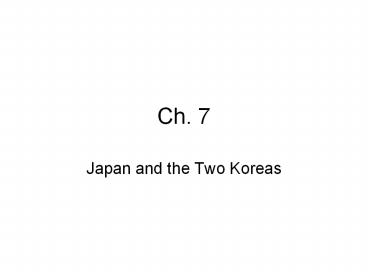Ch. 7 - PowerPoint PPT Presentation
1 / 11
Title: Ch. 7
1
Ch. 7
- Japan and the Two Koreas
2
Japan
- Section 1
3
Japans Land
- Japan experiences thousands of earthquakes a
year. Because it is along the Ring of Fire, the
area around the Pacific Ocean where the earths
crust often shifts. People in Japan also have to
deal with tsunamis. These huge sea waves, created
by undersea earthquakes, cause much destruction
along Japans Pacific coast. - Japan is an archipelago, or a group of islands,
off the coast of eastern Asia between the Sea of
Japan (between Japan and Korea) and the Pacific
Ocean. Four main islands and thousands of smaller
ones make up Japans land area. The four largest
islands are Hokkaido (northern most
island)Honshu, Shikoku, and Kyushu. - The islands are actually peaks of volcanic
mountains. Mount Fuji is the highest peak. Japan
is covered by rugged mountains and steep,
forested hills. - Tokyo, the capital, lies on the Kanto Plain on
Honshu. - Ocean currents and winds affect Japans climate.
The climate differs in the north and south.
4
Japans Economy
- Japans industries benefit from a highly skilled
workforce. - Japan is an industrial giant. They import raw
materials and export manufactured goods. Japans
modern factories use new technology and robots to
make their products quickly and carefully. These
products include automobiles and other vehicles.
Japans factories also produce consumer goods
like electronic equipment, watches, small
appliances, and calculators. - Farmland is limited. Japans farmers use
fertilizers and modern machinery to produce high
crop yields. They also practice intensive
cultivationthey grow crops on every available
piece of land. The chief crop is rice. - Japan imports more fish than any other country.
5
Japans History and Government
- The Japanese trace their ancestry to various
clans, or groups of related families, that lived
on the islands as early as the late A.D. 400s. - Japan was ruled by emperors who modeled society
on the Chinese way of life. In the 790s, the
power of Japanese emperors began to decline. From
the late 1100s to the 1860s, Japan was ruled by
shoguns, or military leaders, and powerful
land-owning warriors known as the samurai. - In the late 1800s, Japanese leaders began to use
western ideas to modernize the country. By the
1900s, Japan was the leading military power in
Asia.
6
Japans History and Government
- During World War II, Japan attacked the United
States. Later, by dropping atomic bombs on two of
its cities, the United States forced Japan to
surrender. One being Hiroshima. - Japans democracy is in the form of a
constitutional monarchy. The emperor is the
official head of state, but elected officials run
the government. Voters elect representatives to
the national legislature. The political party
with the most members chooses a prime minister to
lead the government.
7
Japans People and Culture
- Although about the size of California, Japan has
nearly one-half the population of the entire
United States. The four large cities of Tokyo,
Yokohama, Nagoya, and Osaka form a megalopolis,
or a huge urban area made up of several large
cities and communities near them. - Many Japanese practice two religionsShinto and
Buddhism. - Japans religions have influenced the countrys
arts. Many paintings portray the beauty of
nature, often with a few simple brush strokes.
Some even include verses of poetry. Haiku is a
well-known Japanese form of poetry. - Historical plays in Japanese are called Kabuki.
- A popular Japanese sport is sumo, an ancient form
of wrestling. - Many Japanese are enthusiastic about baseball.
8
The Koreas
- Section 2
9
Divided Country
- The Korean Peninsula juts out from northern
China, between the Sea of Japan and the Yellow
Sea. Today the peninsula is divided into two
nationsCommunist North Korea and non-Communist
South Korea. - China ruled Korea until the A.D. 300s. From A.D.
668 to 935, a single kingdom called Silla united
much of the peninsula. Other dynasties, or ruling
families, followed the Silla. - In 1910 Japan conquered Korea and made it a part
of the Japanese Empire. The Japanese governed
Korea until 1945. - After World War II, troops from the Communist
Soviet Union took over the northern half of
Korea. American troops occupied the southern
half. Korea eventually divided along the 38th
parallel. - The government owns and runs the factories and
farms. - In 1950 North Korea, hoping to unite the country
under communism, attacked South Korea. The United
Nations, led by the United States, rushed to
support South Korea. The Korean War ended in 1953
without a peace treaty or a victor.
10
South Korea the capital is Seoul
- Monsoons affect South Koreas climate. A monsoon
is the seasonal wind that blows over Asia for
months at a time. During the summer, a monsoon
from the south brings hot, humid weather. In the
winter a monsoon blows in from the north,
bringing cold, dry weather. - Manufacturing and trade dominate the economy.
South Korea is a leading exporter of ships, cars,
textiles, computers, and electronic appliances. - The major crops are rice, barley, onions,
potatoes, cabbage, apples, and tangerines. - The people of the two Koreas belong to the same
Korean ethnic group. - Christianity, Buddhism, and Confucianism are
South Koreas major religions.
11
North Korea
- North Korea is slightly larger than South Korea.
It is separate from China by the Yalu River.
Capital is Pyongyang. - North Korea is economically poor. The North
Korean government owns and runs factories and
farms. It spends much money on the military. - North Korean farms do not grow enough food to
feed the country. - A lack of fertilizer recently produced famines,
or severe food shortages.































